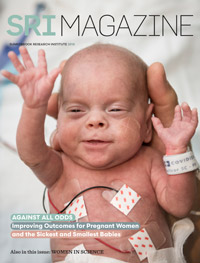Targeted triage and more funding needed to improve heart procedure process
For trans-catheter aortic valve implantation surgeries, careful patient selection is essential
Depending on whom you ask, the average person spends between two and five years waiting in line. Queuing for the bus or a table at the newly opened restaurant is annoying, but when the payoff at the end is a potentially life-saving medical procedure, a long wait can have grave consequences.

Dr. Harindra Wijeysundera researches wait times for trans-catheter aortic valve implantation in Ontario.
“You have patients who are left waiting with a very serious underlying condition, which is anxiety provoking, but above and beyond that, when they’re waiting, they get worse,” says Dr. Harindra Wijeysundera, an interventional cardiologist at Sunnybrook and a senior scientist in the Schulich Heart Research Program at Sunnybrook Research Institute. “I can only imagine how difficult it is for families. It is a helpless situation to be in as a care provider.”
Wijeysundera specializes in trans-catheter aortic valve implantation (TAVI), a minimally invasive procedure in which a new valve is installed in the heart via a catheter wound through the body’s blood vessels. Since its introduction to Ontario hospitals in 2007, TAVI has become the new standard of care for treating some patients with severe aortic stenosis, a condition in which the aortic valve narrows and restricts blood flow from the heart to the body. It’s a serious disease. Left untreated, the survival rate is 50% at two years and 20% at five years. The valve procedure offers an alternative to the open-heart surgery routinely used to replace damaged valves, but that could not be offered to elderly and frail patients deemed inoperable. Even so, for certain people with aortic stenosis the risk of rehospitalization and mortality remains high, regardless of surgical treatment.
As criteria for TAVI expanded and the province approved funding for the treatment, referrals for TAVI increased from roughly 450 in 2012 to 1,550 in 2015. So, too, did the number of procedures, albeit at a slower pace. “Year on year, the number of TAVI procedures done in this country and in this province has gone up,” says Wijeysundera. “But has that increase in capacity kept pace with the increase in demand, as reflected by wait times?”
To answer that question, he and his team led by Dr. Gabby Elbaz-Greener, a research fellow in his program, turned to the CorHealth Ontario TAVI registry, which collects data on patient characteristics, referrals and TAVI-related procedures from 10 hospitals across the province and other health information databases. They found that between April 1, 2010 and March 31, 2016, the average wait time from referral to treatment was 105 days. When the researchers compared wait times before and after September 2012—that’s when the Ontario Ministry of Health and Long-Term Care approved funding for the procedure—they observed an initial decline in the pre-funding era, after which wait times remained nearly unchanged at 82 to 84 days.
“The fact that wait times have stayed essentially the same means that we’re in balance,” says Wijeysundera. “That’s a good thing, but it’s not necessarily an appropriate thing because that 100 days might be too long.” Indeed, his team found that for patients on the wait list, their odds of being hospitalized with heart failure was 14.7%, while their risk of dying was 4.3%—similar to the post-TAVI mortality rate. “The biggest predictor of dying on the waitlist was being on the wait list,” he says. “We will almost always have some degree of wait time; so, how do we triage patients and decide who should go first?”
One-half of this problem is identifying patients for whom TAVI is not suitable and taking them off the wait list. According to Wijeysundera’s study, which was published in March 2018 in the journal Circulation, cardiologists are getting better at determining which patients would not benefit and would be better served with palliation and comfort care. In these cases, the time from the initial referral to being taken off the wait list dropped from 90 to 32 days.
Armed with these data, Wijeysundera is working to convince policy-makers that there is a clear need for greater funding for TAVI procedures. He is a member of an advisory group that offers recommendations to the health ministry on how best to allocate funding and improve patient access to life-saving medical treatments. “I’ve been privileged in that I get to do the research, and through my membership in those advisory committees, I’m also able to present that to the policy-makers so that they have this [data] at their fingertips when they make those decisions.”
— Betty Zou
This research is funded by the Heart and Stroke Foundation of Canada, Institute for Clinical Evaluative Sciences, Ontario Ministry of Health and Long-Term Care, and Ontario Ministry of Research, Innovation and Science.



